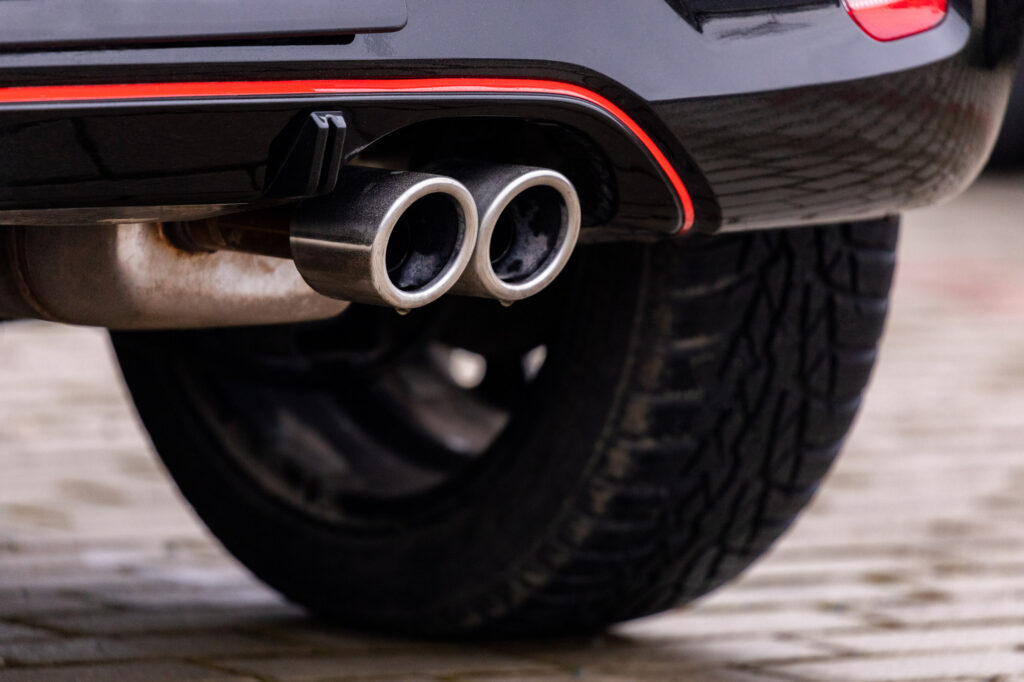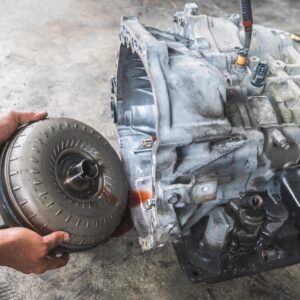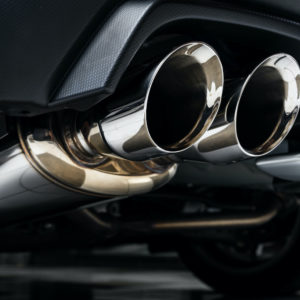You can’t always see what is going on under your vehicle, particularly in the exhaust system. Some drivers forget to inspect it until they notice performance issues with their daily driver.
A damaged or worn-out muffler is one of the most common issues that can happen in the exhaust system, which can easily lead to more complicated problems if left unaddressed.
If the damage is too great, there’s no other option but to replace the old muffler with a new one.
The Principle Behind Mufflers
The muffler silences the engine exhaust. When the exhaust valve opens, a high-pressure gas is released, sending a strong air pressure wave through the atmosphere in the exhaust system.
The strong air pressure wave comes in pulses, which are called explosions. These pulses of explosion blend in a steady roar. The muffler catches these bursts of high-pressure exhaust gas from the cylinder and smooths out the pressure pulses before they’re released at a steady rate.

The muffler houses perforated tubes, baffles, and other such sound-deadening methods to deal with these noise bursts. From there, the smooth-flowing gases are released to the tailpipe. Most mufflers are made to have an inlet diameter that’s larger than its outlet diameter. The exhaust expands and cools as it enters the muffler.
Some vehicle designs feature resonators in the exhaust system, sort of like a glass pack type muffler that is behind the regular muffler, sometimes near the tailpipe, and the catalytic converter doubles as a secondary muffler. With this setup, exhaust gas flow can be smoothed out because of the additional expansion space at critical points in the exhaust system.
Most mufflers have a small hole in the rear to drain the accumulated water, which forms and accumulates in the exhaust whenever gasoline is burned in the cylinder.
During combustion, hydrogen particles from the fuel mix with the oxygen in the air to form water vapor. For every gallon of fuel consumed in a healthy engine, a gallon of water is produced this way. The water vapor then condenses on the cooler surfaces of the exhaust system, particularly in the muffler.
The muffler and tailpipe are supported by hangers, which help isolate exhaust noise from the rest of the vehicle. Exhaust system hangers can either be rubberized fabric or standard rubber.
Rubberized fabric hangers are those that come with metal ends to hold the muffler and tailpipe in place. Doing so prevents the two parts from touching any other metal part in the vehicle, reducing exhaust noise in the process.
Meanwhile, rubber hangers look like large rubber bands that slip over the hooks on the exhaust system. The hooks are then connected to the rest of the vehicle’s body.
If the exhaust system is “in a bind,” even with hangers, exhaust noise may be transmitted to the body. This is sometimes called “body boom” by manufacturers. To alleviate this, you can loosen (not remove) the exhaust where it connects to the engine and then start the engine. With your foot on the brake, move the transmission from drive to reverse so that the engine moves slightly on its mounts, so that the exhaust can unbind itself.
Unbinding it this way can reduce exhaust noise if a bound up exhaust system is the reason for the noise.
How Much Does a Muffler Cost?
The average cost to replace a muffler can range anywhere from $50 to $250, depending on factors like the muffler’s brand, finish, and your vehicle’s specifications (year, make, and model).
As for labor, you can expect to throw in another $70 to $90 on top of your parts receipt.
Replacing a Muffler: A DIY-Friendly Task?
The complexity of a muffler replacement task will depend on your know-how when it comes to auto repair, as well as the overall design of your vehicle.
Replacing a muffler is sometimes considered a DIY-friendly task that you can do in the comfort of your garage. However, keep in mind that the job might require you to operate a few contraptions like jacks or other heavy-lifting equipment.
Your success may depend on whether or not you have an air hammer and/or an acetylene torch and know how to use them safely. It’s very easy to get in over your head trying to replace parts of the exhaust system in your driveway, so be careful. And if you don’t do it right, you can cause worse problems for yourself later on.
There are some instances where the replacement muffler has a different flange than the original one, which will require you to cut and weld the old one for the new muffler to fit.
In cases where cutting and welding are necessary, it’s best to simply leave the muffler replacement job to a trained professional to ensure that the new part is installed correctly.
When Should You Replace Your Muffler?
Most of the time, diagnosing a faulty muffler is visual in nature. Excessive corrosion and wear are telltale signs that indicate the need for a new muffler.
Besides physical damage, there are other symptoms that point to a failing muffler.
No-Start and No-Air
If you’re unable to start your vehicle or no air is coming out of the tailpipe, the muffler may be clogged. Under this circumstance, a muffler replacement is absolutely necessary.
Exhaust Noise
If your exhaust system’s been making new and unusual noises that can be heard from inside the cabin, it’s possible that the muffler has failed or that there is an exhaust leak somewhere else. This is particularly true if the noise is coming from underneath the vehicle.
Poor Fuel Economy
If you notice that you’ve been making trips to the gas station more frequently than normal, it might be best to check your muffler for any signs of damage.
Note, however, that if the catalyst and muffler aren’t externally damaged but are causing exhaust flow problems due to internal issues, you might not see anything even with the vehicle on a lift if you don’t measure temperature at the inlet and outlet or use a vacuum gauge to measure how well the engine is breathing.
Foul Odor From the Exhaust
A worn-out muffler is a potential cause of exhaust leaks. If you notice a strong exhaust smell coming out of your air conditioning vents, you might want to check your muffler for signs of damage.
Is It Safe to Drive With a Damaged Muffler?
While your vehicle might exhibit minimal performance problems because of a damaged muffler, you can’t rule out the greater risks that come with leaving the issue unaddressed.
Many experts strongly advise against driving a vehicle with a damaged muffler for many reasons.
The harmful exhaust fumes can affect your health, as well as the environment. If the damage is too great, your vehicle could break down and leave you stranded on the side of the road.
When it comes to vehicles, always remember that even the smallest parts can cause the biggest inconvenience, so make sure to address damaged or worn-out parts as soon as possible.
Note from Richard McCuistian, ASE Certified Master Automobile Technician:
One autopsy documentary episode chronicles a man whose personality and behavior began to change and eventually he left town, drove hundreds of miles in an odd direction, and then parked his small car, got out, walked away from it, and perished in the middle of an open field.
The end of that story was that his car was found to have several exhaust leaks and his relatives noticed themselves getting light-headed whenever they drove the vehicle after it was retrieved from where the man left it parked beside the road.
It was determined that carbon monoxide poisoning had caused his personality to change and eventually caused him to lose his mind on that long trip.
State Laws Surrounding Mufflers
Most states have laws requiring drivers to have a fully functioning muffler, including Alabama, Alaska, Colorado, Delaware, Florida, and California, among others.
Most of the state laws address exhaust systems in general, stating that system parts should be efficient in reducing harmful emissions and suppressing excessive exhaust noise.
Have You Found the Perfect Muffler?
It’s time to place your order. Normally, it would take a lot of time and money to have auto parts delivered to your home. Fortunately, with a CarParts Plus membership, you won’t have to worry about these shipping concerns ever again.
CarParts+ offers excellent benefits, including free shipping. This means you’ll get easy access to 500,000 unique parts – all of which are ready to be delivered right to your doorstep.
You’ll also get access to other exclusive perks such as VIP Customer Service, 24/7 Roadside Assistance, and Extended Returns. Sign up for CarParts Plus today to have that extra confidence on the road.
Any information provided on this Website is for informational purposes only and is not intended to replace consultation with a professional mechanic. The accuracy and timeliness of the information may change from the time of publication.

































